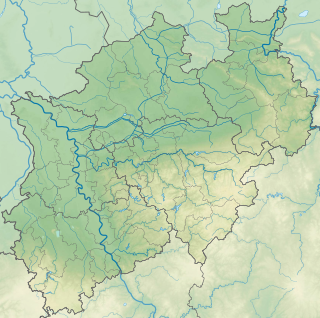Elberfeld limestone sink
| Elberfeld limestone sink | |||
|---|---|---|---|
| View from Kiesberg to the Elberfeld limestone basin | |||
| Systematics according to | Handbook of the natural spatial structure of Germany | ||
| Greater region 1st order | Low mountain range threshold | ||
| Greater region 2nd order | Rhenish Slate Mountains | ||
| Main unit group | 33 → Süderbergland |
||
| About main unit | 337 → Bergisch-Sauerland lowlands |
||
| 4th order region (main unit) |
337 1 → Bergisch-Märkisches hill country |
||
| 5th order region | 337 1 .3 → Wuppertal Valley |
||
| Natural space |
337 1 .35 → Elberfeld limestone sink |
||
| Geographical location | |||
| Coordinates | 51 ° 15 ′ 21 ″ N , 7 ° 9 ′ 1 ″ E | ||
|
|||
| Local area | Elberfeld | ||
| local community | Wuppertal | ||
| state | North Rhine-Westphalia | ||
| Country | Germany | ||
The Elberfeld limestone sink is a natural spatial unit with the order number 337 1 .35 in the urban area of the Bergisch city of Wuppertal ( Elberfeld district ) within the Wuppertal sink . The depression consists of heavily folded mass limestone from the Central Devon, which has been eroded and karstified by heavy rainfall .
The almost closed central chamber of the Elberfeld limestone sink encompasses the valley floor of the Wupper , which is at an average height of 150 m and rises to the north up to 200 m on limestone plateaus. These limestone plateaus are steep-walled and are divided into individual plateaus by side and dry valleys . In the valley, on the rubble cone of the Mirker Bach, the historic city center of Elberfeld is located with the old Elberfeld Castle and the city's most important business district.
Further north and south, steep slopes rise to high ridges and plateaus (up to 300 m), which consist of greywacke and slate . In the east, the Hardtschieferrücke separates the Elberfelder from the Barmer Kalksenke . The separation from the Sonnborn limestone area in the west by the Nützenberg cross bar is even clearer .
The depression is completely occupied by the dense settlement and commercial areas of the industrial city of Wuppertal. The federal highway 7 and the Elberfeld – Dortmund railway line follow the course of the river within the depression.
Individual evidence
- ^ A b c d Karlheinz Paffen, Adolf Schüttler, Heinrich Müller-Miny (edit.): Handbook of the natural spatial structure of Germany: Sheet 108/109: Düsseldorf / Erkelenz. 1963, DNB 456722408 and digital version of the associated map (PDF; 7.1 MB)

